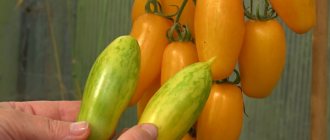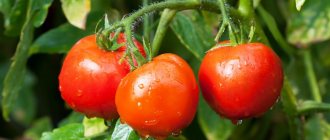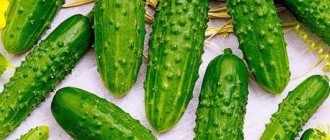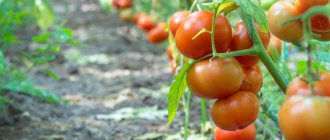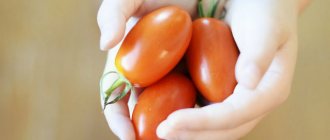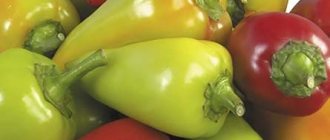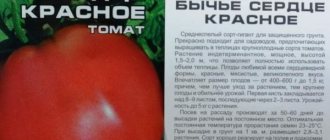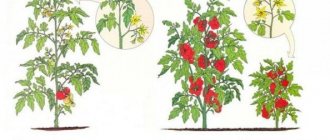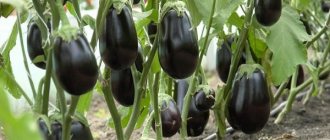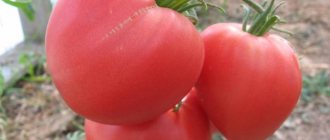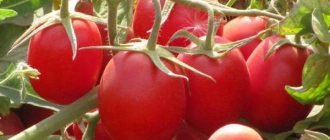The largest-fruited varieties and their detailed characteristics
For many summer residents, the size of the vegetable grown matters. They have an excellent appearance for trading at the market, they can be shown off to a neighbor or simply served as a decoration. Their taste qualities, as a rule, are slightly inferior to small fruits, but growing a couple of bushes of such vegetables will not hurt every summer resident. We present to your attention the largest-fruited varieties of tomatoes for open ground and their detailed descriptions.
- Pudovik. Powerful. A tall bush (up to 150 cm), which produces up to a dozen fruits weighing from 200 g to 1 kg. The Pudovik tomato is considered one of the largest in Russia; it is grown in almost all regions, even in the northern ones. The period until technical ripeness is 115 days, considered mid-early. The yield is 5 kg from one bush or up to 17 kg per 1 m2. With good feeding with mineral fertilizers, the plant’s immunity becomes much stronger.
- Tolstoy. It is impossible to consider the best tomatoes for open ground and not mention this hybrid, which over the 25 years of its existence on the Russian market has become a bestseller, like the Budenovka variety. Its predecessor was the Tolstoy tomato variety, which has been known to all summer residents for at least 20 years. The average fruit weight is 230 grams, which is a good indicator. In addition to its large size, the Tolstoy F1 tomato has another significant advantage - high yield. Collect 12 kg/1 sq.m. This is not a record; this can be obtained on an ordinary summer cottage. The bushes grow up to 120 centimeters, spreading, no pinching is required. Ripening period – 150 days. Tomato Tolstoy is highly resistant to many diseases, including powdery mildew and fusarium wilt.
- Tomato Bull's heart. This is one of the most famous “heavyweights”, which has an excellent appearance, good taste and weighs up to 900 g. The average fruit weighs no more than 300 g, while the first inflorescences produce very large tomatoes, and those that ripen a little later can reach only 100-150 g. Has an excellent decorative appearance - heart shape. The bushes are spreading, erect, powerful, up to 130 centimeters. Bull's heart tomatoes are in great demand among summer residents who grow vegetables for themselves.
Remember that large fruits do not always mean high yields. As a rule, these are more decorative vegetables for home and garden, which have no industrial value. If you seriously decide to engage in vegetable growing, then it would be best for you to choose a hybrid that produces up to 12-20 kg per square meter.
Tomato 'Batyanya'
When it comes to delicious tomatoes that you just want to eat straight from the bush, these are certainly pink and raspberry heart-shaped varieties, among which one of the best is 'Batyanya' from Siberian breeders.
Tomato 'Batyanya'. Photo from the site womanadvice.ru. Its fruits close-up. Photo from the site moya-dacha.com.ua
- height: 1.7-2.0 m;
- ripening period: ultra-early (90 days);
- raspberry-colored fruits; heart-shaped; weighing 200-350 g, sweet taste;
- use: for fresh consumption.
Nuances of cultivation: in the south - in a stake culture, that is, with a garter to a strong stake up to 2 m high, because 'Batyanya' is an indeterminate beauty.
The best varieties of tomatoes for open ground
When choosing tomatoes for open ground in the Moscow region, preference is given to early-ripening, low-growing or medium-growing varieties that set fruit under unfavorable weather conditions.
Low-growing tomatoes for canning
The priority requirements for pickling tomatoes are small size, smooth ripening, dense skin and pulp.
Fighter (Brawler)
Weekend gardeners will benefit from drought-resistant tomatoes that do not require special care, such as the Fighter variety, which ripens on the 95th day after germination. The standard plant reaches a height of 45 cm and does not need a garter. Cylindrical red fruits weigh from 67 to 88 g. The peculiarity of the variety is dark green, highly corrugated leaves. The fighter is little susceptible to bacterial and viral infections.
The tomato variety Fighter also has another name - Buyan
Snowdrop
All-purpose tomatoes are also popular in the Moscow region. The cold-resistant, early-ripening variety Snowdrop goes both in salads and for pickling. The determinate plant requires staking due to the heaviness of the fruit clusters. Productivity - 6 kg per 1 m2. Red fruits gain weight up to 130 g.
The tomato variety Snowdrop is one of the largest early tomatoes.
Northern baby
Stress-resistant varieties are grown in the Moscow region. The determinate variety Northern Malyutka does not suffer from either root or crown rot. The weight of red round fruits is 45–60 g. The yield is only 1.9 kg per 1 m2, but the tomatoes ripen very early.
The Northern Baby tomato variety does not suffer from root and blossom end rot.
Salad tomatoes
Although pickled tomatoes are also eaten fresh, you want a rich taste. It is possible to grow salad tomatoes in the garden if you choose varieties of early and medium ripening. They are also cultivated in greenhouses, but outside (if the weather is sunny) they will pick up more sugar, because sweetness depends on the light. Salad varieties are not necessarily large-fruited, but they are eaten fresh, since they are not suitable for preservation due to their thin skin and loose pulp.
Dad
Tomatoes, which are undemanding to soil fertility, are especially valued. The tall variety Batyanya needs staking and shaping, but the effort pays off with aromatic tomatoes. Fleshy, heart-shaped raspberry fruits weigh up to 200 g and are used fresh and for making juices.
Tomato Batyanya was bred on the basis of the Bull's Heart variety
Boni MM
Along with new ones, gardeners sow proven tomatoes that never fail. The standard salad variety Boni MM reaches a height of 50 cm and is crowned (the stem ends with a flower cluster and stops growing). Flat, slightly ribbed fruits ripen on the 83–88th day after emergence. The first inflorescence is formed above the 6–7th leaf. Fruit weight is 58–63 g with a yield of 5.5–6.5 kg per 1 m2.
Tomato Boni MM produces small, tasty, round-shaped fruits
Golden heart
Orange-fruited tomatoes will add a bright note to the salad. The early ripening variety Golden Heart ripens on the 95th day after germination. Fruit weight: 90–107 g. Diet juice is made from ripe tomatoes. The value of the variety is its yield (7 kg per 1 m2) and the increased content of beta-carotene in the fruits.
Tomato Golden Heart is an original variety bred by Yuri Ivanovich Panchev
Wonder of the earth
Hardy tomatoes have been developed that set fruit even under unfavorable conditions and temperature changes. The mid-season variety Miracle of the Earth is the record holder for yield among salad tomatoes. Although the plant is determinate, with regular potassium fertilizing, up to 13 kg of fruits are removed from 1 m2. The weight of round raspberry tomatoes reaches 380 g.
The Miracle of the Earth tomato fruit has four-lobed pulp
When I first started gardening and lived in a cold climate, the most problem-free tomatoes for growing outside were Balcony Miracle and Irishka. The last tomato, despite its tiny size, has a pleasant taste. The varieties bore fruit on sandy soil, without fertilizers.
Having gained experience, I grew more finicky large-fruited tomatoes that required additional feeding. I remember the Orange variety. The delicate, buttery sweet taste of these tomatoes has never been found in any other orange-fruited variety. The famous Persimmon, Honey Spas and De Barao yellow are not endowed with such an aroma. Orange is a mid-season variety that requires support and pinching, but is worth the effort.
Tomato 'Volgograd'
I remember this variety from childhood; my dad loved it very much. It was he who once, with words of declaration of love, first brought its seeds to my mother. And she grew beautiful compact tomatoes of excellent taste. I remember that dad plucked them from the bush and ate them unwashed, since the plants were not treated with anything, because they did not get sick.
Tomato 'Volgograd'. Photo from sel-hoz.com. Photo from the site teplichniku.ru
- height: 0.7-1.0 m;
- ripening period: mid-season (116 days);
- red colored fruits; flat-round shape; weighing 90-150 g, with a classic tomato taste;
- use: for fresh consumption, salads, juices, ketchups, lecho and stuffing.
Growing nuances: it is better to form 2-3 stems, without a garter. The variety showed itself to be very productive when my mother planted it on the ridges, in a checkerboard pattern.
The best tomato varieties for 2021 for the regions
The same variety in different climatic conditions will feel completely different. The yield will also differ
Therefore, when choosing tomatoes, you should pay attention to zoned varieties.
For the Moscow region
The climate of the Moscow region is quite variable, so it is better to grow tomatoes under film. The following types have proven themselves well:
- Andromeda (ripening period 90–100 days);
- Nevsky (90–100 days);
- Sweet bunch (85–90 days);
- Alenka (90–100 days);
- Medok (85–90 days);
- Mongolian dwarf (90–100 days)
- Rose honey (100–110 days).
It is impossible not to mention here De Barao (pictured below), he is considered the best in the Moscow region and has a reputation as deserved and respected.
For the Urals
For the Ural climate with its short, cool summers, determinate and standard varieties with a short ripening period and resistant to changing weather are best suited. The following tomatoes may be suitable for growing in greenhouses:
- Bersola F1 (ripening period 90 days);
- Kostroma F1 (105–110 days);
- Titanic F1 (110–115 days);
- Fair Lady F1 (95–100 days);
- Lelya F1 (95–100 days).
For open ground you can use the following varieties of tomatoes:
- Siberian early ripening (ripening period 100–110 days);
- Siberian Express F1 (100 days);
- Gina (100–110 days);
- King of Siberia (100–110 days);
- Sugar bison (105–110 days);
- Oak F1 (110–115 days).
For the middle band
The climate of central Russia differs little from that near Moscow, so you can grow the same tomatoes there as in the Moscow region. In addition, you can grow the following tomatoes:
- Red Arrow F1 (Maturing period 100–105 days);
- Sunny (95–110 days);
- Doris (110–120 days);
- White filling (100–115 days);
- Alpatyeva 905A (100–105 days).
Tomato 'Ashdod F1'
This is not only an exotic dark hybrid of the so-called “chocolate tomatoes,” but also an unusually healing vegetable: its fruits, like pink ones, contain more lycopene than red and yellow tomatoes. These tomatoes are used to prevent cancer and cardiovascular diseases, reducing the risk of heart attacks and strokes.
Tomato 'Ashdod F1'. Photo from the site dachamechty.ru. Its fruits. Photo from ogorodsadovod.com
- height: 1.5-2 m;
- ripening period: early ripening, early ripening (85-90 days);
- fruits are dark red-brown in color; round shape; weighing 130-170 g, with a unique luxurious, gradually revealing taste;
- use: for fresh consumption, salads.
Growing nuances: an indeterminate hybrid needs support and garter of shoots. It is resistant to diseases, so my friends do not treat it with anything in the open ground.
Method for selecting a suitable variety
The main condition for a good result in the middle zone is the weather conditions in August - only a dry and hot month guarantees a positive result for tomato lovers. It turns out that fighting late blight is quite easy under any weather conditions this summer. You should remember (write it down), perform small mathematical calculations and follow simple tips:
- Do not rush to sow seeds for tomato seedlings for unprotected soil. The ideal age of seedlings is 50-60 days (from the moment of soaking or planting in the ground).
- Never rush to plant seedlings in the ground. Wait until the threat of frost has passed.
- Calculate the duration of the favorable tomato period for your area. For example, according to long-term observations of agricultural technicians in the Moscow region, the final threat of night cold snaps occurs after June 5-10. For the same region, active late blight damage begins with the appearance of “August dew” in the middle of the month. Therefore, good conditions will last 65−70 days, and seedlings for open ground should be planted on April 5−10.
- Remember that the conditions for growing seedlings at home are not ideal and this affects the timing and height of the formation of the first inflorescence, and also take into account the so-called loss of seedling run when transplanting into open ground (acclimatization) - 5-10 days. Rounded, this figure is 15 days.
Thus, by adding to the constant 50−60 (age of seedlings) variable values of favorable development 65−70 (for the Moscow region) and subtracting 15 (suspension in development), the maximum duration of the growing season is calculated for tomatoes suitable for growing in open ground in the middle zone — 100−115 days.
In the classification by ripening time, these figures correspond only to early ripening varieties. Therefore, when purchasing seeds or seedlings of early-ripening, mid-ripening or late-ripening tomatoes, you will “work” at your own peril and risk.
A few tips you shouldn't ignore
However, even when growing only early varieties of tomatoes, it should be remembered that in the conditions of the middle zone, by the time the risk of major late blight damage arises, they will only just begin to ripen. Therefore, in order to collect the largest possible number of ripe tomatoes, you need to follow the following recommendations:
- Use covering technology. If possible, build simple frames (0.6 m) with film, but preferably white covering material. Using this technique allows you to plant seedlings 10-25 days earlier than the date of the last return frost (June 10) and thereby extend the favorable period. Make sure that the tomato leaves do not touch the film. Such shelters do not need to be ventilated.
- Limit the number of stepsons and brushes. Growing tomato monsters with a large number of shoots, shoots and fruits will not lead to improved results. Remove excess shoots, including underground ones, weekly. Regardless of any recommendations in the description of the variety, still form a tomato plant with only 1 or 2 stems.
- Remove all inflorescences and ovaries after July 1 - they will take away vitality and prevent the ripening of the fruit. Be sure to pinch the growing point in mid-July and this simple manipulation will help the tomatoes left behind ripen as quickly as possible. Periodically cut off all lower, old and diseased leaves.
- Tie up all the bushes. The method of tying is considered mandatory in agricultural technology for growing early varieties. Staking plants will improve air flow and reduce the risk of disease by limiting leaf-to-soil contact.
Do not forget about prevention - such treatment has a serious impact on the quality of plant development in a favorable period. Use new modern means - for example, Donor and Biofora. Treat the seeds and roots of the seedlings (when transplanting into the ground) and treat the plants every 2 weeks. Do not forget about regular loosening and fertilizing.
Zoning varieties
In the process of spreading tomatoes throughout Russia, local breeders are constantly working on developing crops that will be most productive for the northern regions, including the middle zone. In the State Register, the Middle Volga region is referred to as the Middle Volga region of admission No. 7. It includes the following territories:
- The Republic of Mordovia;
- Penza region;
- Samara Region;
- Republic of Tatarstan;
- Ulyanovsk region.
Today, the State Register contains a huge variety of varieties and hybrids, which are zoned for these regions. In addition, other varieties can be cultivated in the middle zone. Most often these are F1 (first generation) hybrids obtained by crossing specially selected parental lines. Such tomatoes are characterized by good productivity, high quality fruits and resistance to unfavorable climatic conditions. Their disadvantages include the fact that they are more expensive, and it will not be possible to collect your own planting material for the next season.
Related article:
7 rules for a large tomato harvest
Tomato varieties for 2021: the best producers
There are quite a lot of agricultural firms in Russia engaged in the production of seed products. Some of them have been on the market for a long time and have a well-deserved reputation for reliability. Here are some of them:
- Vendor code. The company has been on the market for quite a long time (since 1990), but its name is not familiar to everyone. The lack of advertising is partly to blame here, however, the company’s clients almost unanimously note the high quality of the seeds.
- SeDek. The company was founded in 1995 and is one of the leaders not only in seed production, but also in breeding work. Suffice it to say that more than 450 species of crops bred by the company’s specialists are included in the State Register.
- Russian vegetable garden. The company carries out serious breeding and educational work and publishes its own magazine. It has its own department at the All-Russian Exhibition Center and in the Netherlands.
- Gavrish. A company with more than 20 years of experience. Moreover, breeding work on tomatoes is one of the main activities of the company.
- Aelita. A reputable company that entered the market more than 20 years ago. More than 400 varieties of various crops bred by this company are included in the State Register.
Of course, the list is far from complete. Breeding work is carried out by many agricultural companies, so new varieties of tomatoes appear with enviable regularity.
Tomato ripening time
The next point you should pay attention to is the ripening period of tomatoes.
.
The ripening period is an important characteristic from the moment of seedling emergence to harvesting.
Ripening periods are divided into 3 categories: early-ripening, mid-ripening and late-ripening tomatoes.
.
In the northern regions, late-ripening tomatoes are rarely grown; the main choice lies among early and mid-ripening tomatoes.
An equally important feature when choosing tomato seeds is the size of the fruit, and here, too, everything is not so simple.
Low determinate varieties of tomatoes produce tomatoes of medium small size, but indeterminate varieties can produce very large ones, but this group also includes cocktail tomatoes and cherry tomatoes, which have the smallest fruit sizes from 20 to 40 grams.
Here are the main characteristics to look for when choosing tomato seeds.
Features of growing tomato variety Vologda F1 and its description
Many gardeners try to grow hybrids on their plots, for example, the Vologda tomato. They differ from conventional varieties in their high yield and greater resistance to many diseases. They are obtained as a result of artificial crossing of two varieties.
Typically, packages of hybrid seeds are marked with the F1 symbol. The only thing that is impractical for them is to collect seeds and sow them the next year, since all the maternal qualities of the plant will be lost.
You will have to purchase new seeds every year from specialized stores.
Among the hybrids, the tomato variety Vologda F1 enjoys attention
Description of the variety
Vologda F1 is a mid-season variety. From germination to fruiting there are 110 days. The variety is intended for cultivation in film or glass greenhouses. It can have different heights, the maximum reaches 2 meters.
The fruits are collected in a cluster of 6–8 fruits. The leaves are medium in size and dark green in color. The first inflorescences begin to appear above the 10th leaf. The fruits are medium-sized, their weight is from 100 - 110 grams, the color is red, the tomatoes do not crack, and have a durable film. Well attached to the stalk. When the bush matures, it holds tightly and does not fall to the ground.
Tomatoes are distinguished by their taste, contain a sufficient amount of sugar, and are sweetish. Suitable for home and industrial canning and salad preparation.
Breeding Features
Vologda tomatoes are grown in seedlings. The seeds are sown at the end of February. It is advisable to first soak them in water and treat them in a solution of potassium permanganate. Then sow in ready-made moist soil for tomatoes and peppers, purchased at the store. Cover the soil with film and place in a warm place.
In about a week the seeds will sprout. When the first true leaves grow, it is recommended to pick. To do this, it is advisable to choose disposable cups. To extend daylight hours, it is recommended to illuminate the seedlings with a fluorescent lamp. When the plants are 55–60 days old, they must be transplanted into a permanent place in the greenhouse, following a 40x60 cm pattern.
A prerequisite for care is loosening the soil, especially after watering the plants. To increase the yield of tomatoes, it is recommended to loosen and slightly lift the soil up to the first leaves so that an additional root system begins to form.
In the middle zone, tomato seedlings are planted in early May. After some time, the plants need to be tied to a support and fertilized 2 times a month. In the future, they try to form the plant so that there is one stem; when the maximum height is reached, the top is pinched.
This type of procedure is recommended to be done in August. Until approximately August, abundant watering is carried out; at the beginning of August, irrigation is reduced; towards the end of the month, watering is stopped completely.
Advantages of the variety
The advantage of this tomato hybrid is its resistance to many diseases. Tobacco mosaic, fusarium, and cladosporiosis are not dangerous to it. Unfortunately, like all other tomatoes, it can suffer from late blight. The hybrid is characterized by high productivity. With good care, up to 5 kg of tomatoes ripen on one plant.
To obtain high yields, suitable climatic and weather conditions are important. Reviews of Vologda F1 tomatoes are mostly positive
With proper care, most gardeners get high yields and are satisfied with this variety.
Vologda F1 tomatoes are also convenient because they are easy to transport. The fruits have the most convenient size for canning, so we recommend growing them on site.
General principles of growing crops
Tomato varieties for the Volga region can be grown from seeds planted directly into the ground, or from seedlings. The second option is considered the most reliable. This way the seedlings will be able to gain enough strength to grow in an open garden bed. At the same time, the use of seedlings is the key to obtaining an early harvest. Since already grown bushes will be transplanted into the ground as soon as possible.
The period for growing seedlings is 40-70 days, depending on the early maturity of the crop. Early varieties of tomatoes are recommended to be sown for seedlings approximately 40 days before transplanting to a permanent place of residence, medium varieties - 50 days, and late varieties - 70 days. For central Russia, the approximate period for planting vegetable crops in the ground is the second half of May (approximately after 15th). By this time, the soil should warm up to +10...+12 C to the depth of a spade bayonet. If the weather is cold outside, planting should be done in a greenhouse or under covering material.
Summer tips: How to properly sow tomatoes for seedlings
If there is a risk of the temperature dropping at night to 0...+1C or lower, then it is better not to plant the crop in open ground. Young bushes may not tolerate even severe return frosts.
Accordingly, the approximate timing of sowing tomatoes for seedlings in the Volga region will be:
- early varieties – from April 1;
- mid-season - from March 15;
- late - from late February - early March.
Related article:
Tomato diseases and measures to combat them
If planting is carried out in a heated greenhouse, then work can begin even earlier. When growing seedlings, keep in mind that they cannot remain in pots for too long.
Overexposed bushes will be difficult to plant in the garden, and their fruiting will be worse
The best varieties of tomatoes for greenhouses in the Moscow region
Those summer residents who find growing tomatoes a lot of fun can do what they love for almost a whole year. The opportunity to eat fresh vegetables in winter prompts some to organize the cultivation of tomatoes on the windowsill of an apartment, others to install greenhouses. Although heating greenhouses in winter requires considerable energy costs, the result is worth it. What are the best tomato varieties for greenhouses in the Moscow region?
The most popular varieties of tomatoes for greenhouse conditions in the Moscow region are:
- Blagovest F1. Refers to determinant plants with high productivity. Some summer residents note that with proper cultivation and application of complex fertilizer (superphosphate) during planting in the soil, you can get a fairly generous harvest (20 kg per square). It is allowed to place up to three bushes per square meter. Up to 8 tomatoes can be formed on one brush.
- Search F1. It is also one of the best varieties of tomatoes for the Moscow region in greenhouses. From one square you can collect one and a half to two buckets of tomatoes. The fruits are bulky, juicy, weighing up to one hundred grams. Coloring – red. It is very rare to find fruits with a pink tint. The peculiarity of the Search hybrid is that it is very resistant to diseases (fungal and viral). The bush needs a garter as it can reach a height of 1 m. It is widely used for pickles and pickling.
- Ilyich F1. Ilyich tomatoes should also be considered one of the best varieties of tomatoes for the Moscow region. This greenhouse hybrid has excellent taste. Its fruits are so sweet that you want to eat a lot of them. They are perfectly processed into tomato juice and paste, which can be used to prepare any dishes. The fruits are small and there are a lot of them on one stem. The average weight of one tomato is 150 grams.
The most popular varieties also include: Typhoon F1, Hurricane F1, Sprinter F1, Kronos F1, Pisa F1, Samurai F1, Machaon F1.
Tomato 'Golden Koenigsberg'
The annual champion in taste and keeping quality among the user of our website Chasogor (grown in a greenhouse).
Tomato 'Golden Koenigsberg'. Photo from the site 1semena.ru. Its fruits close-up. Chasogor Photos
- height: 1.5-1.8 m;
- ripening period: mid-season (111-115 days);
- orange colored fruits; cylindrical shape; weighing up to 300 g, with sweet, aromatic, low-seeded pulp.
Tomato 'Golden Königsberg', photo Chasogor
- use: for fresh consumption, canning; lies for a very long time.
Growing nuances: indeterminate, needs support and garter.
Disease resistant
Varieties of vegetables whose fruiting is much longer due to genetic resistance to common tomato diseases associated with climatic conditions.
Ural
- "Dubrava";
- "Ogonyok";
- "Stellate sturgeon";
- "Red Fang";
- "Source";
- "Yamal";
- "Yamal 200";
- "Sovereign F1";
- "Elizabeth F1";
- "Orange Fight F1";
- "Anniversary F1";
- "Eliseevsky F1";
- "Olya F1";
- "Lelya F1";
- "Pink Katya F1";
- "Lyubasha F1".
Marmande
Mid-season, high-yielding variety, with red fruits 250 g, not affected by fungal diseases, withstands the attacks of many pests. Resistant to sudden changes in temperature for weeks, so seedlings can be planted much earlier than usual, about 2.
Roma
High-yielding, mid-early, indeterminate (up to 120 cm) hybrid, requiring pinching, with red fruits weighing 140 g (up to 3-4 kg), extremely resistant to fungal diseases of all types. It is not subject to fusarium wilt, responds well to temperature changes, and can withstand even frosts for the last few weeks.
Siberia
- "Stolypin";
- "Sanka";
- "Honey-sugar";
- "Budenovka";
- "Shuttle";
- Hybrid No. 172;
- "Golden Andromeda"
